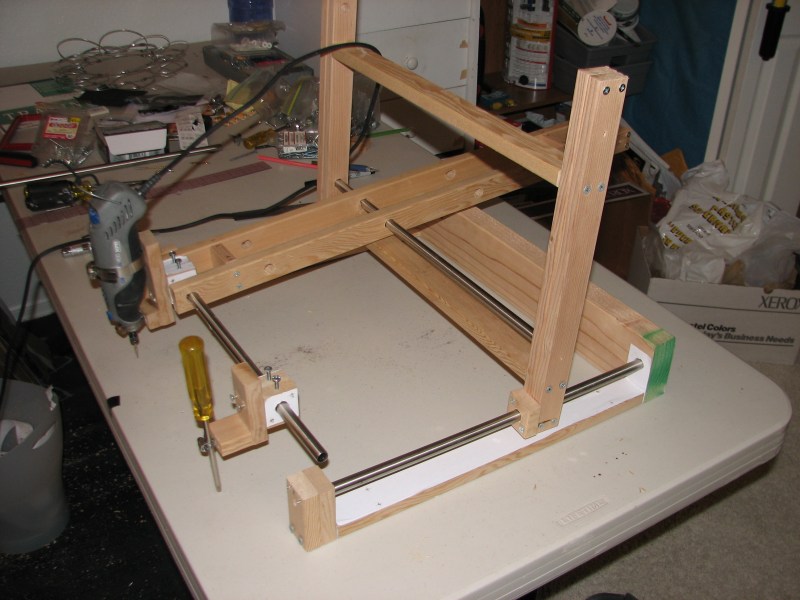[Adran] wanted to be able to accurately cut out a bunch of the same parts out of wood but didn’t have the cash to spend on buying or building an automated CNC machine. After thinking about it for a while he decided to build a mechanical device that will allow him to duplicate objects by tracing them in 3 dimensions. This type of duplicator uses a stylus to trace over the surface of an object while the cutting tool is also moved over a piece of raw material, cutting as it goes. The end result is a newly carved object that is the same shape as the original. The idea is like a pantograph that works in 3 dimensions.
The wood frame is constructed to move freely front to back and left to right. To control the height of the cutting tool, in this case a Dremel, the frame pivots up and down and the X-axis rail. A screw driver is mounted off the side of the Dremel that acts as a stylus. It is mounted in the same orientation as the Dremel bit and is constrained such that it and the Dremel move in the same direction and amount at all times. When the tip of the screwdriver is traced over a 3D part, the Dremel moves the exact same amount carving a part out of a block of material.
Although the machine works, [Adran] admits there is some room for improvement. The left to right motion is a little choppy as the wood frame is riding directly on steel rails. He plans on adding linear bearings for the next revision to smooth things out.
















Look up the Copycarver. Plans are for sale but anyone with a bit of DIY-fu should be able to put one together after looking at the pictures.
http://woodgears.ca/copy_carver/
Love the woodgears site.
+1 for Matthias’s site.
You might also want to check out this floating router – 9 video series as it migrates form idea to useful :)
https://www.youtube.com/watch?v=FT9q-0vK_pQ
I think that, despite the attraction of CNC machines etc, THIS is exactly what many hobbyists actually need for 99% of projects that proport to need a laser cutter and/or a CNC. Such a cool idea :)
It works assuming you have a physical object to copy which is an issue if all you have is a CAD design in electronic form.
You don’t need a physical copy in so much as you need reference objects that can be of any arbitrary shape as long as they include the dimensions and shapes you’re trying to replicate. One can shave the reference copy out of soap, or use multiple different objects in many processing steps to arrive at the result.
That’s a great point Dax.
Depends on what you do. It would work for 0% of the projects I have used my CNC so far.. though many of those could have been done without CNC also.
I think more like 1%.
I would much rather use a manual mill than this or a pantograph unless I had an original object that can’t be easily put into CAD.
There is one that I saw in National Geographic that would carve out a brace of wooden ducks all from a single decoy.
The only difference between a pantograph and a copy carver is that the pantograph doesn’t have a joint at the base that allows it to be lifted.
He would be much better served to build it as a pantograph instead, so there wouldn’t be any catch and slop in the rod bearings.
It’s a shame that the videos of this duplicator are set to “private”, it would be nice to see it in action.
There used to a lathe version of this at Timbertown (settler/19th century theme park) in Wauchope, NSW which was used to duplicate wooden clogs.
Basically the same idea, except the workpiece spun rather than the toolbit.
If he mounted the dremmel the same way he mounted the screwdriver it would add “tilt forward and back” to his copier. Furthermore, making the dremmel and screwdriver mounts rotatable left and right and addiing a connector bar to keep them parallel would provide him with much better control over the duplication
As it is there can be no undercuts of any kind, ,just height matching.
Good one. That’s an elegant fourth axis. Maybe a linked trunnion could give him the fifth axis.
No editing of posts? Sorry, I forgot to add that I admire his creativity. I didn’t want my post to seem critical. This is a great and inspiring work. I only meant to suggest some possible improvements.
Interesting, reminds me somewhat of the pantograph they use to make coins.
Think this one’s been on HaD before, but it demonstrates good results can be had with widely spaced drawer slides for the linear axis:
https://www.youtube.com/watch?v=8wZ1v4PIsYI&index=2&list=PL7A1D94FF4FF10854
Does he know about pantographs? They would allow him to do scaling, too.
So, this does not work (yet), and the videos he put up are ‘private’
Good one